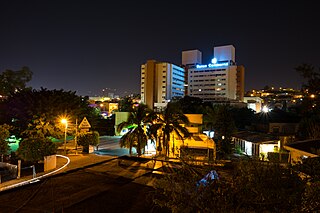
Honduras is divided into 18 departments. Each department is headed by a governor, who is appointed by the President of Honduras. The governor represents the executive branch in the region in addition to acting as intermediary between municipalities and various national authorities; resolves issues arising between municipalities; oversees the penitentiaries and prisons in his department; and regularly works with the various Secretaries of State that form the President's Cabinet. To be eligible for appointment as a governor, the individual must: a) live for five consecutive years in the department; b) be Honduran; c) be older than 18 years of age and; d) know how to read and write.

La Ceiba is a municipality, the capital of the Honduran department of Atlántida and a port city on the northern coast of Honduras in Central America. It is located on the southern edge of the Caribbean, forming part of the south eastern boundary of the Gulf of Honduras. With an estimated population of 209,000 living in approximately 170 residential areas, it is the fourth most populous and third most important city in the country.
La Esperanza is the capital city and a municipality of the same name of the department of Intibucá, Honduras. La Esperanza is famous for having the coolest climate in Honduras. It is considered the heart of the Ruta Lenca, a region of Lenca ethnic influence that spans Honduras from Santa Rosa de Copan to Choluteca. Sites on the Lenca Trail have been designated by the government and United Nations development in order to encourage more cultural tourism, and help create new markets for the traditional crafts, such as pottery, practiced by the Lenca, in order to preserve their culture.
La Paz is the capital city of the La Paz Department of Honduras. The town, founded in 1792, has a population of 32,450.

Santa Bárbara, with a population of 30,690, is the capital city of the Santa Bárbara Department of Honduras and the municipal seat of Santa Bárbara Municipality.

El Progreso is a city, with a population of 120,600, and a municipality located in the Honduran department of Yoro.
Marcala is a town, with a population of 15,050, and a municipality in the Honduran department of La Paz. The region is known for its coffee production, boasting the first "protected origin denomination" for coffee. Marcala has been designated as a center of Lenca Trail, a government and United Nations sponsored development effort to encourage tourism to Lenca communities. It offers visitors perspective on the culture of indigenous people and provides new markets for their traditional crafts.
El Negrito is a town, with an urban population of 13,260 (2023), and a municipality in the department of Yoro, Honduras.
Santa Rita is a town and a municipality in the Honduran department of Yoro. The Humuya River passes through it.

Ocotepeque is a municipality in the Honduran department of Ocotepeque. The town of Nueva Ocotepeque is the municipal seat and the capital of the department.
Jano is a town and municipality in the north west of the Honduran department of Olancho, west of Guata, south of Esquipulas del Norte and north of Manto.
San Esteban is a municipality in the northeast of the Honduran department of Olancho, west of Dulce Nombre de Culmí, east of Gualaco and north of Catacamas. Costa Rican author Oscar Núñez Oliva set his 2000 novel Los Gallos de San Esteban in the municipality.
San Francisco de la Paz is a municipality in the centre of the Honduran department of Olancho.
San Marcos is a town, with a population of 5,660, and a municipality in the Honduran department of Santa Bárbara. Since 2006 it has been known as the "La Capital de los Juegos Tradicionales de Honduras"
Drinking water supply and sanitation coverage in Honduras has increased significantly in the last decades. However, the sector is still characterized by poor service quality and poor efficiency in many places. Coverage gaps still remain, particularly in rural areas.

Education in Honduras is essential to the country of Honduras, for the maintenance, cultivation, and spread of culture and its benefits in Honduran society without discriminating against any particular group. The national education is secular and founded on the essential principles of democracy, inculcating and fomenting strong nationalist sentiments in the students and tying them directly to the economic and social development of the nation. Honduras's 1982 Constitution guarantees the right to education, a right also conveyed through the National Constituent Assembly's Decree 131 and in the official daily publication La Gaceta.

Constituent Assembly elections were held in Honduras on 22 September 1957. In November the Assembly elected Ramón Villeda Morales as president.

Tegucigalpa —formally Tegucigalpa, Municipality of the Central District, and colloquially referred to as Tegus or Teguz—is the capital and largest city of Honduras along with its sister city, Comayagüela.

Honducor is the mail service of Honduras.

Honduras de la Sierra is a municipality in the Mexican state of Chiapas, located approximately 150 kilometres (93 mi) southeast of the state capital of Tuxtla Gutiérrez. Gazetted in 2019, it is the newest municipality in Chiapas.










